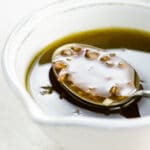Balsamic Shallot Vinaigrette
This balsamic shallot vinaigrette is simple yet nuanced, extremely versatile, perfectly balanced, and easy to keep on hand. Having a jar in the fridge makes it easy to eat your leafy greens. It works equally well on tender lettuces and assertive dark leafy greens like arugula and dandelion.
Servings: 12
Calories: 86kcal
Ingredients
- 1 small shallot minced
- 2 tablespoons (30 ml) balsamic vinegar
- 2 tablespoons (30 ml) red wine vinegar
- ½ teaspoon fine sea salt
- ½ teaspoon granulated sugar
- ¼ teaspoon freshly ground black pepper
- 1 ½ teaspoons (7 grams) dijon mustard
- ½ cup (118 ml) extra-virgin olive oil
Instructions
- Place the shallot, balsamic vinegar, and red wine vinegar into the jar and stir to ensure shallot is covered with vinegar. Let the shallot marinate for a few minutes (two to five is enough) to let the vinegar work its magic and take the bite out of the shallots.
- Add the salt, sugar, pepper, mustard, and olive oil to the jar.
- Close the lid and shake well until dressing is completely emulsified.
Video
Notes
- Instead of sugar, you can use honey, maple syrup, agave, or another sweetener of your choice. These will change the flavor profile, and we prefer the simplicity of a pinch of sugar — but it's up to you. You can also leave the sugar out entirely if you like. We find it rounds out the flavor enough to be worth it.
- For both the balsamic and the red wine vinegar, you can use a midpriced option. You don't need anything super-fancy to make this dressing taste great. You can also swap in other vinegars if you like. White balsamic pairs well with champagne or white wine vinegar. Or use half red wine vinegar and half lemon juice. Play around with the basic formula as much as you like to create your favorite combinations.
- You can also adjust the ratio of oil to vinegar. 2:1 is standard and yields a nice, balanced dressing. But if you like things tangier, you can decrease the oil a bit without changing anything else. Adding a higher percentage of oil would break the emulsion, so I don't recommend doing that.
- Emulsifying means, essentially, getting the vinegar (which is water-based) and the oil to stay blended together even though they're not really supposed to. Vigorous shaking emulsifies this dressing, and the mustard helps it stay that way for a while. Give it a good shake before using.
- The dressing is ready to use right away and will keep well in a nice cold fridge for a week or two. If it solidifies in the fridge (as olive oil can do at colder temperatures), bring to room temperature before using. Or pop the lidless jar into the microwave for about 10 seconds and give it a stir to hasten the process if you like.
Nutrition
Serving: 1 | Calories: 86kcal | Carbohydrates: 1g | Fat: 9g | Saturated Fat: 1g | Polyunsaturated Fat: 8g | Sodium: 106mg | Sugar: 1g
